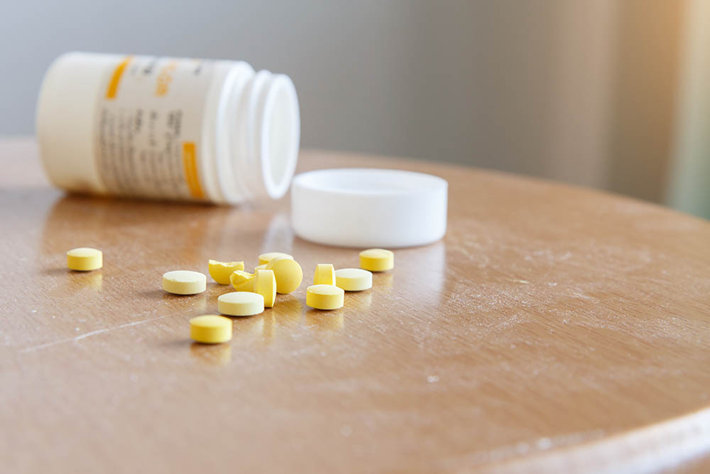Effects of Prescription Drug Abuse

All of the commonly abused prescription drugs are addictive, meaning that one of the primary effects of prescription drug abuse will be addiction. Those abusing these pain relievers, tranquilizers, sedatives and stimulants may require drug rehab to come off these drugs safely and achieve lasting sobriety. Some people will also require medical detoxification before rehabilitation, particularly those addicted to benzodiazepines. Withdrawal from benzodiazepines can be dangerous to mental and physical health without careful medical supervision and care.
Effects to Watch for With Opiates
Prescription drugs that may be abused in this class include hydrocodone, morphine, methadone, codeine, and oxycodone in different formulations under different brand names. Demerol, Darvocet, Lortab, Vicodin, Roxicodone, Opana - there are dozens of brand names used for these pain medications.
Effects of these drugs include sedation, anesthesia, slowed breathing and addiction. An overdose can slow breathing enough to cause death. A person who injects these drugs risks infection at the injection site and around the heart.
When a person suffers from an addiction to opiates, very often his or her entire life suffers. Maintaining the habit becomes more important than any other goal. Parents, spouse, children, job, education, goals - in most cases, these former priorities are forgotten. The addicted person normally overlooks his or her normal care, ignoring cleanliness and proper meals. Health issues may simply be ignored. The person tends to be apathetic and unmoving. Pneumonia and other lung problems can occur.
While the person abusing prescription opiates may feel relaxed and euphoric, he or she will have difficulty concentrating. He will be inattentive and his reflexes and perceptions will be slowed which means it is not safe to drive or operate equipment. Drivers may fall asleep at the wheel.
Addiction to opiates should be addressed at the first possible moment because of the possibility of overdose death. This risk is increased when opiates are combined with alcohol, benzodiazepines or other drugs.
Central Nervous System Depressants: Sedatives and Tranquilizers
This class of drug includes sedatives of the benzodiazepine class, sleep aids like Ambien and Lunesta, and barbiturates like Seconal and Nembutal. These drugs can also slow respiration and also heart rate, so present an increased risk when combined with other drugs, including opiates or alcohol.
A person coming off central nervous system (CNS) depressants should be monitored by a qualified doctor as seizures can occur. CNS depressants slow the brain’s activity so when the drug is withdrawn, the brain activity can rebound into a seizure or other problems. A person may have difficulty with memory when abusing a CNS depressant.
Benzodiazepines are used for their euphoric effects and may be combined with alcohol or cocaine to offset certain undesirable effects or augment the intoxicating effect of the other drug. Drivers abusing these drugs have a significantly greater risk of having an accident, especially when young. In 2008, there were 271,698 visits to emergency rooms as a result of having problems with benzodiazepines. Xanax was the benzodiazepine most frequently associated with trips to the ER.
In all, CNS depressants sent 363,000 people to the emergency room in 2009.
Prescription Stimulants Are Often Considered Study or Work Aids
The main prescription stimulants that are abused are the drugs given to young people when it is considered that they are having trouble focusing. Students who want to abuse the drugs learn to fake the symptoms that may cause doctors to prescribe these drugs to them so they can study long hours, write papers for hours on end and keep up with the competition in high school or college. Brand names of these drugs include Ritalin, Concerta, Adderall, and Strattera.
Desoxyn is another stimulant that may be abused by shift workers or drivers who want to stay alert. A worker can work a double shift if he abuses prescription stimulants but he will severely stress his heart and overall mental and physical health.
Those abusing these drugs to the point of addiction may suffer irregular heartbeat, paranoia, hostility and heart failure.
Addiction is Common to All
Addiction is the one adverse effect that may well be suffered by anyone abusing these drugs. Many people will struggle on for years, trying to get clean, before they find a drug rehab that can help them. For those who find the Narconon drug and alcohol rehabilitation program, their first trip to rehab can often be their last. One phase of this longer-term, eight to ten weeks on average, residential program is critical to each person’s recovery. The Narconon New Life Detoxification sets up the right conditions to flush old stored drug toxins out of each person’s body. When complete, this phase results in clearer thinking, a brighter outlook and by reports of those finishing it, lowered or eliminated cravings for more drugs or alcohol.
Find out how you can help someone get back to the sober, productive life they had before addiction.
Resources:
 ®
®